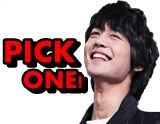According to the latest from China News, the number of products that Super Junior is currently endorsing is five. For a foreign boyband, they have already broken all records for foreign endorsers in China.
When you see them on the news as frequently as local boybands Fahrenheit and Lollipop, do you not think: how did they manage to sweep across the whole of China and mesmerize it?
Ten years ago, H.O.T started the boyband wave in China, and let them know the prowess of Korean boybands then. After that, both Shinhwa and Dong Bang Shin Ki continued the hallyu wave in China, becoming the idols that everyone strived to emulate.
If one had to say who is currently the most popular boyband in China, it has to be the extremely large roundup called Super Junior. Furthermore, the sub-unit SJ-M with Hankyung as its leader has won the hearts of many teenage girls in China.
They have opened up a new route for Korean stars in the Mainland.
Super Junior: the real all-rounded idols
After the successes of artistes such as H.O.T, Shinhwa, Dong Bang Shin Ki and BoA under its wing, the largest entertainment company in Korea, S.M Entertainment then started planning for a refreshing new group for fans.
On the 6th of November 2005, S.M Entertainment officially introduced their new boyband, a thirteen member group consisting of “flower boys”.
This was an important step towards the overseas market for S.M, and the sheer number of people in Super Junior already generated much attention that was needed for the group.
Talents are all-rounded; they’re not only singers
What made Super Junior stand out from the other boybands at that time was that they were comprised of thirteen members that specialized in different areas. They were singers, actors, comedians, composers, models and MCs (Master of Ceremonies, used here to refer to host/singers).
Once they had debuted, all thirteen members had the chance to showcase their own special talent.
One special, Chinese face
In this massive group however, one face stands out and is particularly striking. He is the Chinese member Hankyung (or Hangeng) that was picked via the H.O.T auditions in China during the 2001 edition. He is tall and handsome, and has vast talent in dancing.
Because of his appearance, Super Junior was destined to shine in the Chinese market.
From their first single, Super Junior’s road of fame has been relatively smooth. All of their lead singles from every one of their three albums have been chart-toppers, and they also have had two concert tours around Asia, causing a frenzy everywhere they toured. The members also have had good results in both hosting and acting as well.
Earlier this month, Super Junior appeared as guests for the Golden Melody Awards in Taiwan, and they were ironically more popular than most of the other guests there. Their fans had been mobbing them ever since their touchdown in Taiwan, and they would not cease until SuJu’s departure.
Their popularity even led to the organizing unit specially planning a small copycat version of Super Junior, for more news coverage.
Super Junior-M: the China-focused Korean boyband
Because of Hankyung, more Chinese people now know about and like Super Junior. So at this point of time, S.M made an analytical business decision, and a risky one too: they created a sub-unit within Super Junior, just for the Chinese market.
With Hankyung as its leader, more Chinese members were added in and this is how the mesmerizing SJ-M has come to be.
The group with three Chinese members
The M in SJ-M stands for “Mandarin”, and it also represents that SJ-M will be focusing on the Chinese market as their main stage. Its members comprises of Hankyung, the leader and also the one with the highest popularity in China, Donghae, Siwon, Ryeowook, Kyuhyun, four members from the original unit, two Chinese members were also added: Henry and Zhoumi.
Together they form the seven member SJ-M, and the presence of three Chinese members brings a stronger sense of familiarity for Chinese fans. They are the first boyband to have both Korean and Chinese members, and they are also the first group to train under a Korean entertainment company and enter the Chinese market with the intention of working hard to achieve their goal of being top stars there.
Chinese versions help to close the gap
The truth remains that despite the hallyu wave in China, there is not a shortage of boybands and pretty boys there, all with the ability to sing and dance well. However, SJ-M’s appearance still managed to wow the audience there.
SJ-M’s debut album’s lead single, was the Chinese remake of the original Korean version that Super Junior had sung, and most of the Asian audience were already familiar with this song. It was rearranged by famed Korean composer Yoo Youngjin to include a New Jazz swing beat, and is more emotional than the original version.
The single that shared the same name with the album,
The cute
In order to pull the gap between them and their fans even closer, this Korean-Chinese group even did a cover of the classic Chinese ballad,
(T/N: This is part one of the article, part two is mainly about Hankyung and his struggles in Korea. Will be translated tomorrow because this article is so dang long.
Source:
Translated by: hazel @ http://asianfanatics.net
Please take out with full credits
(T/N: This article is mainly about SJ-M and how SuJu, as a whole and its sub-unit, managed to have much success in China. Hence the source, and the slightly misleading header)






















No comments:
Post a Comment